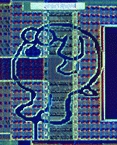Can You Give Me the Time of Day?
I'm a believer in both paying back and paying forward. Among other ways, I've done so by donating my time, documented on these pages, by creating mini-howtos relating to, among other things, running Xandros Linux Deluxe 3.01, which is what I use, (this version costs $89.95USD but you can download a free version that is crippled in some ways) in a Netware environment and how to successfully convert from Windows. I've also paid money to support other Open Source efforts like, for example, the Mozilla Firefox browser. In addition, I've also donated money to the American Red Cross and Salvation Army for Katrina relief. Not to brag or anything, but I've donated close to $3,000USD so far this year to various charitable/non-profit or Open Source projects and have donated at least as much for at least the last three or four years running.
Having done all that, I've very rarely asked for the assistance of anyone but I'm asking for a small favor now.
I have a couple of security cameras at home that transmit their images to a secured folder on my website. Every 30 seconds or so a new image is transmitted from the Seto Shack to my web host in Pittsburgh that overwrites the current one.
My cameras have built in servers that can display or transmit images via the Internet. Although, for a time, I opened a port to the outside world at the Seto Shack so I could access the images directly from the camera via the Internet, I eventually decided it wasn't such a good idea to have a port open at home. So I closed the web port and just have the webcams ftp utility upload images to my website.
Given that setup, what I want to do is modify the image by displaying on the image the date and time that the image was taken. Knowing that fellow Daynoter Brian Bilbrey had a webcam with time/date, I searched his site for what he was using. After narrowing down the search to a number of hits that was usable (using just "webcam" brought up every page with a masthead link to his webcam! My bad.), I found that he is/was using something called Stamp!.
So I downloaded, compiled, and installed Stamp! Although it does add the date and time to an image (it reads the current system and then overlays the image with this information), that's only part of what I want done. I want something that will actually read the date/time of the image file itself and display that in the image. That way, I will know when the image was actually taken, not when Stamp! ran and checked the system date/time (Stamp! runs periodically and is not otherwise keyed to the taking of the image). This would be helpful to me not only for diagnostic purposes (e.g., to check whether new images are being uploaded correctly), but more importantly, also for auditing/legal purposes should an image need to be used in a court of law.
When wouldn't the date/time match when the image was taken? Well, almost every image would be off by as much as 29 seconds but more worrisome is if, for some reason, the webcams should stop transmitting, while at the same time Stamp! keeps running. For example, should someone break into the Seto Shack, it is possible they might disable the security system. Should that occur, no new images would be sent, but Stamp!, running on the webserver that powers seto.org, would continue to run. This means the last image that was sent would continue to have it's image modified with the current time. Over and over again until I turned Stamp! off. In other words, I would have an image that perhaps was taken hours ago, but the date stamp would show the current system time. This would probably cause some problems should I need to use it as evidence before a court.
I tried Googling for something that would actually read the file date/time instead of just reading the system clock but, so far, have been unsuccessful.
In any case, if you know of anything that runs under *nix that could do what I need done, please leave a comment or email using the link in the right column of index page for this web site. Thank you in advance.
[NOON UPDATE]I've found a snippet of Perl code that purports to read a file's time stamp. The code is below:
use File::stat;
use Time::localtime;
$date_string = ctime(stat($file)->mtime);
print "file $file updated at $date_string\n";
When I created a Perl script, by adding the line
#!/usr/bin/perl and changed the
$file place holder with the real
file name of test.jpg, and then
executed the script (after setting the file permission for
execution) I got the following error:
Can't call method "mtime" on an undefined value at ./timer.scr line 5.
timer.scr is the name of the
executed file and line 5 points to $date_string =
ctime(stat($test.jpg)->mtime);
I know next to nothing about Perl so I don't know how to fix this error.


 My wallpaper for the week
comes courtesy of the National Aeronautics and Space Administration. It's
My wallpaper for the week
comes courtesy of the National Aeronautics and Space Administration. It's

